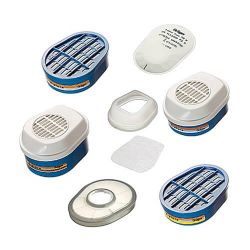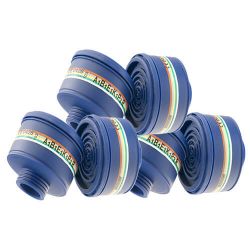Gas mask filters
Find here our large range of filter cartridges for gas masks and powered air purifying respirators. The efficiency of an air purifying respirator primarily depends on its filtering cartridge selected to protect against present gas, vapor or particles. The most difficult is to choose the proper respirator cartridge according to the potential hazards.
There are 3 categories: particles filters (dusts, aerosols, bacteria, viruses), gas filters (gases, organic and inorganic vapors, acids, etc) and combined filters (gas & particles). Please note, any air purifying respirator is efficient only if the oxygen rate in ambient air exceeds 19.5% of the volume.
-
Dräger bayonet filter cartridges for X-plore 3300, 3500 & 5500 gas masks
Starting at €129.00Quickview -
-
-
-
-
-
-
P3 respiratory protection filters (against dust)
Particle respiratory protection filters – also known as aerosol gas mask filters – are mainly used to protect users against dusts, particles, liquid and solid aerosols according to the EN143 standard. They are gathered into 3 efficiency classes (P1, P2 or P3) that ensure a purifying level from 80% to 99.97%.
The most effective protection is class P3 (filtration rate of 99.97%), which should be used as often as possible against tiny dust such as asbestos (level 1), ceramic fibres, and viruses (avian flu, H1N1 flu, coronavirus, etc.) and bacteria.
Particle filters for air purifying respirators (PAPR) feature a large parallel pleated purifying surface which avoid clogging risks in very dusty environments. Because of their hydrophobic characteristic they are water resistant and stop the thinnest particles.
In a dusty environment, particulates filter will progressively clog and offer a higher and higher breathing resistance – without affecting the purifying power. This breathing disturbance will determine the replacement.
Gas filters for APR respirator
Gas filters for APR respirators are especially designed to get protected against toxic substances. These gas mask filters feature a microporous structure made of active carbon with tiny capillaries for an enhanced purifying efficiency while reducing the breathing effort.
As for particle filters, they are gathered into 3 efficiency classes, ensuring a purifying level (3 being the maximum protection level). In addition to the three efficiency levels, there is a specific codification composed by letters and colors for different types of toxic gas and substances.
| Gas class | Color code | Application |
| A | Brown | Organic gases and vapours (solvents) with boiling points above 65°C such as white spirit, styrene or xylene |
| AX | Brown | Gases and vapours of organic compounds with a boiling point below 65°C such as methanol, chloroform or perchloroethylene |
| B | Grey | Inorganic gases and vapours such as chlorine, hydrogen sulphide or hydrocyanic acid) |
| CO | Black | Carbon monoxide |
| E | Yellow | Acid gas and vapor like sulfur dioxide |
| Hg | Red | Mercury vapors |
| I | Orange | Iodine |
| K | Green | Ammonia and organic derivatives |
| NOx | Blue | Nitric oxide, nitrogen oxide, nitrous vapor |
Some respirator filter cartridges can combine simultaneously several gases. This way, a gas mask filter cartridge against organic and inorganic gas and vapor, acids and ammonia – and its derivatives – will be labeled ABEK with a color code brown, grey, yellow, green.
Combined respiratory protection filters (against gas and particles)
As their name implies, combined filters are efficient both against dusts and toxic substances. They consist of 2 barriers placed in series in the cartridge. Because of this virtually unbeatable protection level in the field of air purifying respirator cartridges they are slightly larger than standard gas mask filters.
Their operating principle is very easy to understand: inspired air goes through the particle and aerosol filtering device (like oil or paint droplet e. g.) before going through the gas filter.
The most commonly used respiratory protection filters are:
A2-P3: Organic gases and vapours (solvents) with boiling points above 65°C, solid and liquid particles, radioactive and highly toxic particles, bacteria, and viruses.
A2-P3 Reactor: Same as above with the addition of radioactive iodine (Iodine 131) and methyl iodide.
ABEK2-P3: Organic, inorganic gases and vapours, acid gases, ammonia and its derivatives, solid and liquid particles, radioactive and toxic particles, and micro-organisms like bacteria and viruses.
ABEK2HgNOCO20-P3: Same as above with mercury vapours, carbon monoxide, and nitrogen oxides.
Given that these gas mask filters are airtight to aerosol particles, they are often chosen for liquid spraying works such as painting.
See also



